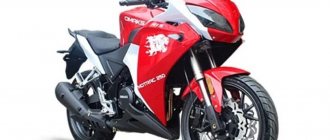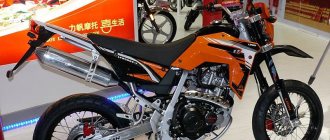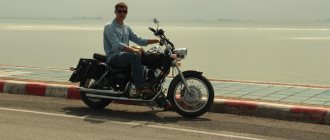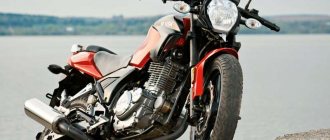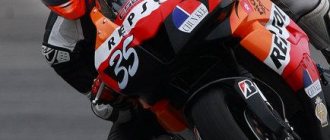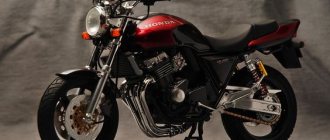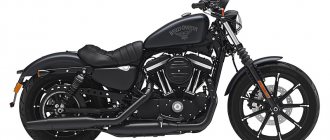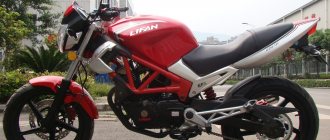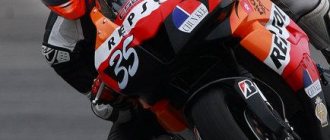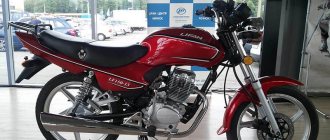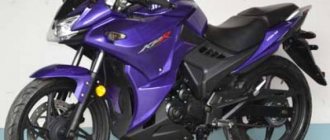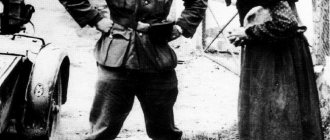The light cruiser Lifan LF250 B is a restyled version of the first model, which, however, differs from the modern one only in appearance. The old Lifan LF250 was an almost exact copy of the Yamaha XV250 Virago, right down to the compatibility of the vast majority of spare parts. It has been produced since 2007, and these motorcycles were imported to Russia by individual small dealers. Later, a new generation went on sale, called Lifan LF250 B and retaining all the advantages of its predecessor. And, it should be noted, there were a lot of them, so the Lifan LF250 B turned out to be, perhaps, the most successful Chinese cruiser of all those produced in the “up to 250 cc” class.
The reason for this is simple: Chinese engineers, fortunately, did not reinvent the wheel, but diligently copied the old Viraga, which was a very successful motorcycle for its time, reliable and unpretentious. Moreover, if you look closely at some parts of the Lifan LF250 engine, you will be surprised to find the “Made on Japan” stamp there. Apparently, this is the reason for the high reliability of this model. Some flaws can only be attributed to purely Chinese components, such as a rapidly stretching standard chain or a frankly weak light bulb in the headlight. Otherwise, the Lifan LF250 B is really quite good. And in general, how many Chinese choppers with a full-fledged V-twin do you know? Even the second exhaust pipe of the Lifan LF250 B is not fake, but the real thing. It’s just that the pipes from the cylinders first go to the resonator, and from there they go directly to the exhaust pipes. In general, everything was thought out and taken into account by Japanese designers.
The Lifan LF250 B motorcycle is still in production. The model really turned out to be successful, noticeably higher quality than the vast majority of Chinese competitors, so the Chinese are in no hurry to discontinue it. This is for the best - for beginner motorcyclists this bike is perfect, especially if they are drawn specifically to cruisers.
001_MOTO_0710_024
Lifan Eagle 250: motard, 2008, 249 cm³, 17 hp, 145 kg.
Lifan Eagle 250: motard, 2008, 249 cm³, 17 hp, 145 kg.
Just a few years ago, in the niche of 250–400 “cubes” in the Russian market, Japanese second-hand goods reigned supreme. Today, many leading manufacturers, be it the Japanese “magnificent four”, KTM or numerous “Piaggian” stepchildren, are leaving this sector of the market (with rare exceptions). And ordinary enterprises from the Middle Kingdom, having perfected their “air blowers” with a working volume of 150–200 cm³, are in no hurry to join the new class. After all, cubic capacity from a quarter of a liter requires a different approach; one “upgrade” will not get rid of it. Effective (liquid) cooling is needed, which means we will have to master the production of radiators, pumps, and electric fans. Other frames, suspensions, brakes will be required...
The largest private motorcycle manufacturer in China, Lifan Group Co., Ltd., was one of the first to take aim at motorcycles of “chekushka” cubic capacity. The products of this motorcycle giant are known in the world under more than 20 brands, and it seems that the Chinese motorcycle industry is flooded with models with 250 cc engines. In fact, there is only one engine - 172MM-2. The three-digit index, traditionally for Chinese technology, does not indicate cubic capacity, but the diameter of the cylinder, if one is discarded. (Note that the CF-Moto company produces scooter motors of the same size.) It would be naive to believe that Lifan created a new motor for the sake of one model. It is also installed on motard-related enduros, choppers, all-terrain vehicles... The Lifan LF250ST-2 quad with this engine has been sold in Russia since 2007, but two-wheeled vehicles were only brought in, and then as prototypes. They were tested on the Kovrov ZiD, a long-time partner of Lifan. By the beginning of our test, the Lifan Eagle 250 had covered about 4,000 km on local roads. There is only one breakdown - the “tail” fastening has burst. The Chinese must have not taken into account the outstanding dimensions and weight of the Russian license plate!
Similar models
- Irbis Garpia 250, a product of Chinese-Russian love. A good bike for the money that rides quite confidently and looks quite stylish.
- Reggy Cowboy 250 . It is an almost 100% copy of the first generation Lifan LF250. According to reviews from the owners, there are minor assembly flaws that can be easily eliminated on your own.
- Yamaha XV250 Virago . This used “Japanese”, which became the progenitor of the Lifan LF250, can be purchased for money comparable to buying a new “Chinese”.
002_MOTO_0710_024
The pendulum is pleasing to the eye - aluminum, and polished at that.
But the frame remained steel and heavy. The rear brake is a single disc, single piston. A design long ago worked out by the Japanese on motards and enduros. The pendulum is pleasing to the eye - aluminum, and polished at that. But the frame remained steel and heavy. The rear brake is a single disc, single piston. A design long ago worked out by the Japanese on motards and enduros.
Approximate price
You can buy Lifan LF250-19P both in specialized motorcycle dealerships and through the official dealer network of the manufacturer.
In the first case, the price spread can be quite significant and reach 115,000 - 130,000 rubles.
At official ZiD dealers, the motorcycle is sold at a fixed price of 119,400 rubles, but this does not include delivery.
If we talk about ZiD dealers, then most of them are in the European part of Russia, but residents of the Far East have to be content with only one center, which is located in Khabarovsk.
Do you want to see with your own eyes how the Honda CB 600F reaches 245 km/h? Then this video clip is for you.
Description of the technical characteristics of the domestically produced ATV Stels ATV 300B.
003_MOTO_0710_024
The power of the four-stroke engine is only 17 hp.
Not much by modern standards. But there is plenty of cooling reserve, especially since the system is liquid. But there is also a minus - the water pump took the place of the kick. The power of the four-stroke engine is only 17 hp. Not much by modern standards. But there is plenty of cooling reserve, especially since the system is liquid. But there is also a minus - the water pump took the place of the kick.
Manufacturer
Lifan was founded in 1992. In addition to passenger cars, motorcycles, ATVs and scooters, buses are also produced under this brand.
The plant is not very large by world standards and employs a little more than 13.5 thousand workers, but this does not prevent the company from regularly being included in the list of the 500 largest companies in China.
Lifan has been developing joint projects with Russian business for 6 years; in particular, an assembly plant for the production of cars was organized.
The brand’s own plant is being built in Karachay-Cherkessia, in Russia not far from Lipetsk. In addition, motorcycles of this brand are produced in Kovrov.
004_MOTO_0710_024
The speedometer is pointer, but electronic: the signal comes to it from the sensor on the front brake disc.
And the accuracy is like GPS. True, at night the too bright blue backlight is annoying. The speedometer is pointer, but electronic: the signal comes to it from the sensor on the front brake disc. And the accuracy is like GPS. True, at night the too bright blue backlight is annoying.
Photo gallery
As you can see in the photographs, the motorcycle has few plastic body kit elements. Therefore, it has a rather aggressive exterior, in which attention is focused specifically on the frame.
005_MOTO_0710_024
The pentagon headlight looks modern.
But it shines in the old fashioned way - instead of the long-familiar halogen, it has the usual “Ilyich bulb”. The turn signal legs could have been worse. The pentagon headlight looks modern. But it shines in the old fashioned way - instead of the long-familiar halogen, it has the usual “Ilyich bulb”. The turn signal legs could have been worse.
I began my acquaintance with the device by studying the documentation - an extensive European certificate on 37 pages. From it I learned that a three-component catalytic converter is installed in the exhaust system (but you can’t tell by looking at it!). It indicates both the noise level (82 dB) and the design maximum speed of 100 km/h. The latter seemed too small for such a cubic capacity. Let's check! Since the motorcycle has been broken in for a long time, I give it full throttle. Along the way, I note the features of the transmission: 1st and 2nd gears are short, and 4th and 5th, on the contrary, are long. Well, the “maximum speed” really turned out to be about 110 km/h both according to GPS and speedometer. The latter is electronic (with a sensor on the front brake disc), only with a dial indicator. But in terms of dynamics up to “hundreds”, the “Eagle” is head and shoulders above any 200 cc Chinese-made enduro.
After a full load, until the engine cooled down, I decided to check the operation of the cooling system by letting the engine run in place. The system has two radiators, one with an electric fan. Although the air warmed up above 20 0C and I drove intensively, the fan turned on only after about five minutes. During this time I took a closer look at the device. The faceted headlight gives the motorcycle a modern and memorable look. Unfortunately, the Chinese cheated: they equipped it with a simple “Ilyich light bulb”; there weren’t enough yuan for a halogen lamp. That’s why, as night trips showed, the light is unimportant—a C grade. But the speedometer lights up with a blue light too much. By the way, all the lights are controlled by one switch: high, low, dimensions, off. Unusual, but convenient.
An impressive muffler also benefits the appearance of the motorcycle. The eye also catches the pendulum - it is aluminum, and polished at that. But the frame and small attachments are made of steel, so it’s not surprising that the bike weighs about one and a half centners. Of course, everything in the world is relative, but for a motard with a 17 hp engine. It’s too much, you can’t fool around to your heart’s content!
Pros and cons of Lifan LF250 B
Advantages
- High reliability . Many Lifan LF250 owners can boast of impressive mileage and the absence of any noteworthy breakdowns.
- Modest fuel consumption . Of course, the consumption of 2.5 liters per 100 km declared by the manufacturer is achievable only in ideal conditions and when driving at a speed of about 80 km/h on the highway, but even if you squeeze everything that it is capable of out of the Lifan LF250, gasoline consumption will not exceed 3.2-3.5 liters per 100 km.
- Easy to maintain . You can carry out service operations and, if necessary, repair the motorcycle on your own. In addition, the manual for the Yamaha XV250 Virago is 95% suitable for the Lifan LF250.
- Almost all spare parts are suitable from the aforementioned Viraga, both from 250 cc and 125 cc.
- If you have some imagination, you can hang a lot of universal chopper tuning - mirrors, panniers, backrest, trunk, chandelier, roll bars and much more.
- dynamics by class standards . And thanks to its good maneuverability in city traffic jams, the bike can easily leave behind most of its more powerful and massive brothers.
Flaws
- The presence of an oil filter not provided for by the design . Its role is played by a regular mesh, through which the smallest particles of dirt can seep through. Well, at least it's easy to clean.
- Original spare parts are sometimes quite difficult to obtain. And suitable analogues from Yamaha Virago are sometimes obscenely expensive.
- The rear drum brake is ineffective. In addition, it is easily blocked if you overdo it with pressing force.
- The presence of a passenger immediately negatively affects the acceleration dynamics and braking efficiency.
006_MOTO_0710_024
The mid-travel fork and 17-inch wheels allow the saddle to be quite low - 770 mm - so it is also suitable for short riders.
But it’s better to forget about annealing: a significant weight (145 kg) combined with low power (17 hp) suggests a moderately dynamic driving style. However, this motorcycle is from an experimental batch. The chassis allows you to install a more powerful engine. The mid-travel fork and 17-inch wheels allow the saddle to be quite low - 770 mm - so it is also suitable for short riders. But it’s better to forget about annealing: a significant weight (145 kg) combined with low power (17 hp) suggests a moderately dynamic driving style. However, this motorcycle is from an experimental batch. The chassis allows you to install a more powerful engine.
The suspension allows this “Eagle” to proudly soar above the entire Chinese motorcycle industry: an inverted fork, with protection, and, moreover, quite functional. It seemed a little harsh to me: small irregularities are transmitted to the hands, although it copes with large holes with dignity. It’s a pity that there are no adjustments to complete the compliment. The stated stroke is 165 mm, but judging by the traces of erased dirt, it does not exceed 140–145 mm. But the monoshock absorber, on the contrary, is a bit soft. But this is fixable: the rigidity can be adjusted with a screw for the slot, and you can also pump up (or bleed) air. The frame is quite rigid: the motorcycle does not wobble on uneven corners. Tires of truly Motard size from the large Taiwanese company Duro, one of the industry leaders. But the brakes are “just there”: simple single-disc, but they cope with the responsibilities.
The mid-travel fork and 17-inch wheels made it possible to make the saddle low enough (770 mm), so that both the driver and the passenger can easily fit on the motorcycle. The length of the saddle is average (600 mm before bending onto the tank). There are large steel handles on the sides, which are convenient for the passenger to hold on to, but the footrests provided for him are scanty.
The clutch pressure sensor allows you to start the engine when the gear is engaged; There is a blockage from the side stop sensor. On the instrument panel there is a clearly readable gear indicator (from 1 to 5). The rotary design enrichment is located on the left steering wheel handle. The original “stop engine” is in the form of a rotating petal. But there is no kick - in its place is a water pump. So the owners will have to pray for the reliability of Chinese electrics. There was no room on the motard for a tool and a small shmurdyak. At first I didn’t believe it - I removed the saddle, for which I had to first unscrew two screws, remove the left trim, and then use a hex key to unscrew the screws securing the saddle. There is no room there, and that’s it!
009_MOTO_0710_024
The motard accelerates very quickly to “hundreds”, but then sours: its “maximum speed” is 110 km/h.
This is probably how it was intended: the first two gears are short, the last are long, “economical”. And it’s true - you can drive up to 300 km on an 11-liter tank! The motard accelerates very quickly to “hundreds”, but then sours: its “maximum speed” is 110 km/h. This is probably how it was intended: the first two gears are short, the last are long, “economical”. And it’s true - you can drive up to 300 km on an 11-liter tank!
Over 5,000 km, we were able to collect operational statistics. The gas tank (11 l) is enough for 250–300 km, depending on the “degree of annealing”. A chain without seals (with an “Izhevsk” pitch) served a little more than this period and was replaced due to stretching. At the beginning of operation, play was noticed in the needle bearings of the pendulum, it was eliminated by broaching and it did not occur again. Also, when the gas was sharply opened in fifth gear, the clutch slipped, but this situation did not develop. The turn signal switch lock turned out to be weak, and the “oak” legs of the flashers themselves were alarming. But we must not forget that this motorcycle is the first of the experimental batch. In general, the Lifan Eagle 250 has made a decisive step forward compared to other “Chinese” models. If only there was a little more power...
Technical characteristics of Lifan Eagle 250 (manufacturer data)
| COMMON DATA | |
| Model | LF250GY-7 |
| Year of issue | 2008 |
| Length/base, mm | 2170/1440 |
| Dry weight, kg | 145 |
| Seat height, mm | 770 |
| Steering wheel width, mm | 870 |
| Ground clearance, mm | 230 |
| Gas tank volume, l | 11 |
| Load capacity, kg | 158 |
| Maximum speed, km/h | 110 |
| ENGINE | |
| Type | 1-cylinder, 4T |
| timing belt | ONS-2 |
| Working volume, cm³ | 249 |
| Cylinder diameter × piston stroke, mm | 72x61.2 |
| Max. power, hp at rpm | 17/7500 |
| Max. torque, Nm at rpm | 18,2/5500 |
| Supply system | carburetor |
| Cooling system | liquid |
| Starting system | electric starter |
| TRANSMISSION | |
| Clutch | multi-disc, oil bath |
| Transmission | 5-speed |
| main gear | chain |
| CHASSIS | |
| Frame | steel spatial |
| Front suspension | inverted telescopic fork |
| Wheel travel, mm | 165 |
| Rear suspension | pendulum, with adjustable monoshock absorber and spring preload |
| Wheel travel, mm | n.d. |
| Front brake | disc ∅ 270 mm, 2-piston caliper |
| Rear brake | disc ∅ 220 mm, 1-piston caliper |
| Front tire | 110/70–17 |
| Rear tire | 130/70–17 |
The equipment for the test was provided by Kovrov OJSC ZiD. We thank the Nikolaev Korzhevins (senior and junior) for their help in conducting the test.
Mid-flying bird - Lifan Eagle 250
Reviews from Lifan LF250 B owners
The motorcycle has been in production for a long time, I bought mine in 2014 secondhand, according to the title of 2008, the first generation, but the first owner took it from the showroom in 2010. I got my Lifan with 28,000 km of mileage, a collective farm headlight and a couple of marks on the sides. The previous owner took good care of the bike, changed the oil every 3000 km, the air filter was bought from a Japanese company to make replacement easier, there are many analogues. Now the odometer has almost 60,000 km already, the clutch has been replaced with the original one from Viraga 250 (discs, spring, release), and other little things. The motorcycle is really reliable, it doesn’t let you down, the only unexpected breakdown is a burnt out light bulb. Well, the chrome has started to peel off in places, but not critically. Dmitry, Tula, Lifan LF250 '2008.
Under my weight (120kg), the Lifan LF250 drives lazily, but, in principle, I didn’t expect anything else from it. The bike has 12k mileage now, it rides fine, I ride it to work during the season, in traffic jams - it’s just right. There are no jambs. The pendants are weak. Ilya,>
An excellent chopper for its price, it is head and shoulders better in all respects than all these similar Chinese cramps with single-cylinder engines, they weigh the same, but at the same time they do not move at all. I tried on a friend’s Keeway Supershadow 200 cc - in general, a complete vegetable. The Lifan LF 250 is much more energetic, not a rocket, of course, but it confidently gains its fair hundred. The bike feels light, I applied it a couple of times due to inexperience and lifted it easily, although I myself am not a jock at all. It steers fabulously and brakes tolerably. Vladislav, Krasnodar, Lifan LF250 B '2017.
